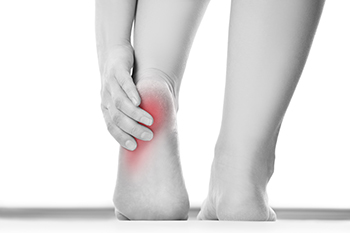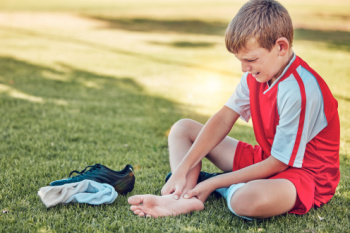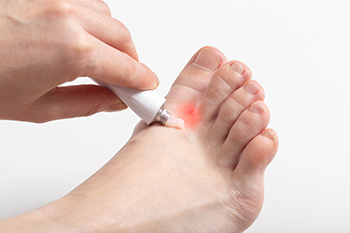Connect With Us
Blog
Items filtered by date: March 2025
What You Need to Know About Heel Pain

Heel pain is one of the most frequent reasons people visit a chiropodist. It often starts as a sharp or aching pain in the bottom or back of the heel. One of the leading causes is plantar fasciitis, which results from inflammation of the band of tissue that supports your arch. Other causes include Achilles tendinitis, heel spurs, bursitis, or stress fractures. Heel pain can make walking difficult and affect your daily activities. Wearing unsupportive shoes, standing for long periods of time, or increasing physical activity too quickly can make the problem worse. Early treatment is important and may include stretching exercises, wearing supportive footwear, or custom orthotics. In more serious cases, additional therapies or medical procedures may be recommended. If you have heel pain that does not improve, it is suggested that you see a chiropodist who can provide an accurate diagnosis and a personalized treatment plan.
Heel pain is a common problem that can be caused by a variety of injuries, medical conditions, and other factors. If you suffer from heel pain, please consult with Paul A. Scotti, D.Ch from West Toronto Foot & Ankle Clinic Inc. . Our chiropodist can help you maintain the health of your lower limbs and your mobility.
When it comes to heel pain, the exact location and type of pain are important to note. Some of the conditions that may cause heel pain include:
Plantar fasciitis - An inflammation of the ligament that runs along the bottom of the foot; it causes a stabbing pain under the heel that is at its worst when taking your first few steps after a long rest and while standing on your tiptoes or climbing stairs
Achilles tendonitis - An inflammation of the tendon in the back of the calf; it causes pain in the back of the heel that is at its worst after resting, as well as ankle and calf stiffness, swelling, and tenderness
Bone spurs - Bony lumps on the back of the heel bones that cause sharp pain upon first standing up; the pain becomes dull and achy over time
Heel fractures - A break or crack in the heel bone that causes pain, swelling, and difficulty walking
Retrocalcaneal bursitis - Swelling of the small, fluid-filled sac at the back of the heel bone; it causes pain, swelling, redness, and warmth in the back of the heel
Tarsal tunnel syndrome - Compression of the posterior tibial nerve which causes a pins and needles sensation in the heel, foot, and calf
Your chiropodist will be able to diagnose the underlying cause of your pain and prescribe the right treatments for you. If you have any questions, please feel free to contact our office located in . We offer the newest diagnostic and treatment technologies for all your foot care needs.
How Kickball Can Hurt Kids’ Feet

Kickball is all about running, kicking, and quick movements, but these actions can put stress on a child’s feet. Forceful kicking can bruise the top of the foot, causing pain and swelling. Running on hard surfaces, especially without proper footwear, may lead to heel pain or inflammation in the arch. Fast stops and sudden turns increase the risk of ankle sprains, while awkward landings can result in toe fractures. Repeated bending of the big toe during powerful kicks can cause turf toe, a painful sprain that makes movement difficult. Kids who play frequently may also develop overuse injuries that linger beyond the game. Supportive athletic shoes with good cushioning and grip can help prevent many of these injuries. If a child experiences ongoing pain or swelling from playing kickball, it is suggested that you schedule an appointment with a chiropodist who can provide treatment to keep your children active and injury-free.
Injuries to the foot and ankle are very common among athletes. If you have experienced an injury, please consult with Paul A. Scotti, D.Ch from West Toronto Foot & Ankle Clinic Inc. . Our chiropodist will assess your condition and provide you with quality foot and ankle treatment.
Common Injuries Among Athletes:
Achilles tendon injuries
Ankle strains or sprains
Plantar fasciitis
Fractures
Turf toe
Joint dislocations
Sever’s disease
Morton’s neuroma
Symptoms
Symptoms will depend on the cause and severity of the injury. Common symptoms for a foot or ankle injury include pain, swelling, tenderness, bruising, a reduced range of motion, and difficulty bearing weight or walking on the affected foot or ankle.
Diagnosis
Sports injuries are typically diagnosed after carefully examining the affected foot or ankle. This includes moving the injured area to test its range of motion. Medical history will need to be provided, as well as detailed information about how the injury occurred. Imaging studies, such as X-rays or MRIs, may be used to confirm or rule out certain diagnoses.
Treatment
Just like symptoms, treatment will depend on the type of injury and its severity. Initial treatment for many sports injuries is aimed at controlling inflammation and promoting the healing response. The acronym R.I.C.E is a helpful guide to implement for most acute injuries. This method involves resting, icing, compressing, and elevating the affected foot or ankle. In addition, anti-inflammatory medications may be administered and orthotic devices may be prescribed. For more severe injuries, surgery may be required. Lastly, rehabilitation or physical therapy may be needed to gain full functionality in the afflicted area.
If you have any questions, please feel free to contact our office located in . We offer the newest diagnostic and treatment technologies for all your foot care needs.
Causes of Arch Pain and Stretches for Relief

Pain in the arch of the foot can result from various conditions that affect the muscles, tendons, and ligaments. Plantar fasciitis is a common cause, occurring when the thick band of tissue along the bottom of the foot becomes inflamed due to overuse or strain. Flat feet, high arches, or improper footwear can also place excessive stress on the arch. Tight calf muscles or Achilles tendon issues may contribute to discomfort by altering foot mechanics. Gentle stretches can help relieve tension and improve flexibility. Stretching the calf by pressing the heel down while leaning forward against a wall can reduce strain on the arch. Rolling a ball under the foot and performing toe stretches can also provide relief. If you have pain in this part of your foot, it is suggested that you schedule an appointment with a chiropodist who can determine what the cause is and offer you appropriate relief and treatment techniques.
Foot pain can have many causes. To receive an accurate diagnosis and treatment for your foot pain, please consult with Paul A. Scotti, D.Ch from West Toronto Foot & Ankle Clinic Inc. . Our chiropodist will assess your condition and provide you with quality foot and ankle treatment.
Causes
There are a variety of different conditions that can cause foot pain, including:
Plantar fasciitis
Deformities, such as bunions or hammertoes
Injuries to the muscles, bones, tendons, or ligaments in the feet
Arthritis
Flat feet
Ingrown toenails
Symptoms
The type and location of your foot pain can help determine what may be causing it and what type of treatment options are best for you.
Common types of foot pain include:
Heel pain
Arch pain
Toe pain
Ball of foot pain
Pain that has a stabbing, burning, or tingling quality
Pain that is constant, intermittent, or that gets better or worse depending on the situation
Diagnosis
A thorough medical history and physical examination of your feet will be required to determine a diagnosis. Imaging studies, such as X-rays or MRIs may be performed to rule out or confirm certain diagnoses.
Treatment
Treatment will depend on the cause of the pain. Common treatments for foot pain include resting, icing, compressing, and elevating the affected foot, wearing orthotics, or taking anti-inflammatory medications.
If you have any questions, please feel free to contact our office located in . We offer the newest diagnostic and treatment technologies for all your foot care needs.
We Can Treat Your Foot or Ankle Pain
How Athlete’s Foot Is Treated

Athlete's foot, or tinea pedis, is a contagious fungal infection that affects the skin of the feet, often beginning between the toes. It thrives in warm, damp environments like locker rooms, showers, and sweaty shoes. The condition causes itching, burning, redness, and cracked or peeling skin. In some cases, small blisters or scaling may occur, making the feet uncomfortable and unsightly. To manage athlete’s foot, keep your feet clean and dry, especially between the toes. Avoid walking barefoot in public areas and change your socks and shoes regularly. Disinfect shared surfaces to prevent reinfection. If symptoms persist, worsen, or cause significant discomfort, it is suggested that you see a chiropodist. They can confirm the diagnosis and recommend prescribed medications or advanced care to ensure the infection clears up effectively.
Athlete’s foot can be uncomfortable and unsightly. To learn more about preventing and treating this condition, please consult with Paul A. Scotti, D.Ch from West Toronto Foot & Ankle Clinic Inc. . Our chiropodist will assess your condition and provide you with quality foot and ankle treatment.
What Is Athlete’s Foot?
Athlete’s foot refers to an infection of the skin on the feet that is caused by a fungus. This fungus is contagious and thrives in warm and moist environments. It is often spread in common areas such as public pools, locker rooms, and showers. It can also spread when sharing personal items, like shoes or towels, with an infected person.
Symptoms
The symptoms of athlete’s foot may include:
Itching, stinging, or burning of the skin on the feet
Cracking or peeling skin, especially between the toes and on the soles of the feet
Scaly, red rash on the foot
Blisters
Foul odor
Treatment
Treatment for athlete’s foot typically involves using over-the-counter topical antifungal medications on the feet. When over-the-counter options are ineffective, you may need to take prescription oral medications or topical antifungal drugs, or a combination of both.
Prevention
Preventing athlete’s foot places an emphasis on good foot hygiene practices.
You can prevent athlete’s foot by:
Washing and drying your feet thoroughly every day
Wearing shoes when walking in public areas
Not sharing personal items, like shoes or socks, with others
Wearing shoes and socks made out of breathable materials
If you have any questions, please feel free to contact our office located in . We offer the newest diagnostic and treatment technologies for all your foot care needs.
Blog Archives
- April 2025
- March 2025
- February 2025
- January 2025
- December 2024
- November 2024
- October 2024
- September 2024
- August 2024
- July 2024
- June 2024
- May 2024
- April 2024
- March 2024
- February 2024
- January 2024
- December 2023
- November 2023
- October 2023
- September 2023
- August 2023
- July 2023
- June 2023
- May 2023
- April 2023
- March 2023
- February 2023
- January 2023
- December 2022
- November 2022
- October 2022
- September 2022
- August 2022
- July 2022
- June 2022
- May 2022
- April 2022
- March 2022
- February 2022
- January 2022
- December 2021
- November 2021
- October 2021
- September 2021
- August 2021
- July 2021
- June 2021
- May 2021
- April 2021
- February 2021
- January 2021

